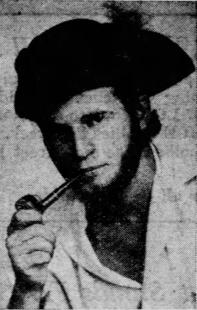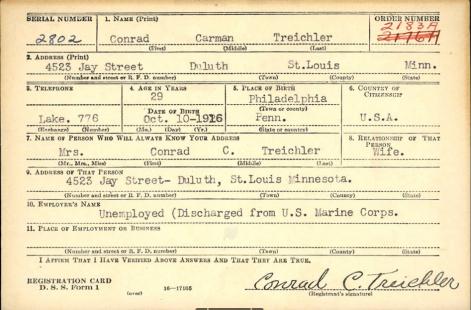Conrad Carman Treichler
Era: World War II
Military Branch: Marines


TREICHLER, Conrad Carman
Conrad Carnan Treichler was born on October 10th 1916 to Loren & Margaret Threichler in Philadelphia, Pennsylvania.
Mr. Treichler enlisted in the U.S. Marine Corps from Duluth, Minnesota. He served in World War II with the Marines and was assigned to 3rd Defense Battalion Marines. His rank was Private 1st Class.
Mr. Treichler was present at the bombing of Pearl Harbor on December 7, 1941. Below is a description of his experience firing on the Japanese attackers.
After the war he married Dorothy Marie Peterson and they raised a family.
Mr. Treichler died on October 18th 2009 at 93 years of age.
Source: Duluth News Tribune, December 8, 2008 (article, see below); information provided by veteran.
Article: “Veterans Honor Victims of Attack on Pearl Harbor”
“Pearl Harbor survivors Conrad Treichler (from right) of Boy River, Minnesota, and Harold Baker of Duluth honor those who died in the attack during Pearl Harbor Day. Remembrance ceremony behind the Duluth Entertainment Convention Center on Sunday. Baker’s son-in-law, Dennis Ahlin, also of Duluth, stands beside him.”
Information from veteran:
Conrad C. Treichler
AGE ON DEC. 7TH, 1941………………………….25
RANK OR RATE ON DEC. 7TH, 1941……………PFC
SHIP OR STATION ON DEC. 7TH, 1941…………3rd Def. Bn. FMF USMC
BATTLE STATION ON DEC. 7TH, 1941…………Marine Barracks, Pearl Harbor
Description of What You Remember of the Attack on Pearl Harbor:
"Sunday, 7 December 1941 was just another lazy tropical day in the life of the Third Defense Battalion Marines. All those not on watch, or assigned duty, could “sleep in.”"
"I woke up to the whine of planes and a terrible explosion. From a barracks window I saw a plane with a red circle on its side climbing toward the sky. Someone yelled, “Those are Japs”. We grabbed our rifles and poured out of the barracks as the field music sounded “Call to Arms.” A short time later, we obtained ammunition from the storerooms, and then available civilian workmen were mustered and put to work loading machine gun belts. We took 50 and 30 caliber anti-aircraft machine guns from our warehouse, some still covered with Cosmo line, and put them into action within 10 minutes of the initial surprise attack."
"Low flying Jap Torpedo bombers skimmed over our barracks, strafing all of us who were scattered over the parade ground and athletic field. One Jap pilot flew directly into our anti-aircraft and rifle fire, started to smoke, and crashed about 1½ miles away at the Naval Base Hospital grounds. Our Executive Officer, Major H. C. Roberts (K.I.A. at Okinawa) obtained a wing from the torpedo bomber and stood this bullet-riddled wing in front of battalion headquarters. It was said that “ground fire” was useless against aircraft, but the plane had about 200 holes in it from machine gun and rifle fire. The Jap pilot was dead, with nine bullet wounds in the head and torso. We were using our 1903 Springfield 30-06 bolt-action rifles. Later, some Marines used pliers and wire cutters to cut pieces out of the “red ball” on the wing."
"The Jap raiders were slow in pulling out of their power dives, making them perfect targets. One of our machine gunners, who the week before had been on the machine gun range, said, “Hell, they are easier to hit than sleeves.”"
"We were deployed in groups to concentrate rifle fire on dive-bombers, and 3 anti-aircraft batteries were being emplaced when the last attack (about 3 hours later) was made by a large number of highflying bombers. They appeared directly overhead at about 10,000 feet, and flight discipline was excellent despite the heavy barrage from the ships 5” guns and our 3” anti-aircraft fire. We watched sticks of high explosive bombs fall from the planes, then lost sight of them as they gained momentum during their fall and breathed easier only after hearing the explosion. I remember seeing one group of bombs falling in a diamond-shaped pattern and making a wide arc as they fell. They must have missed a target, because after they hit there was no fire or smoke. I remember one terrific explosion, which shook the ground we were on, followed by an immense cloud of black smoke which seemed to cover half the sky. Someone said later it was the U.S.S. Arizona being hit. After another explosion I saw a giant plume of debris and several white objects raise several hundred feet in the air. We heard later it was from the dry dock where the U.S.S. Pennsylvania was. I have often wondered if the white objects were sailors."
"Our battalion was lucky. We had only 4 casualties—all shrapnel wound . . . and all recovered. After the attack, we were assigned reserve duty and beach defense positions."
Albert J. Amatuzio Research Center | Veterans Memorial Hall (vets-hall.org)

